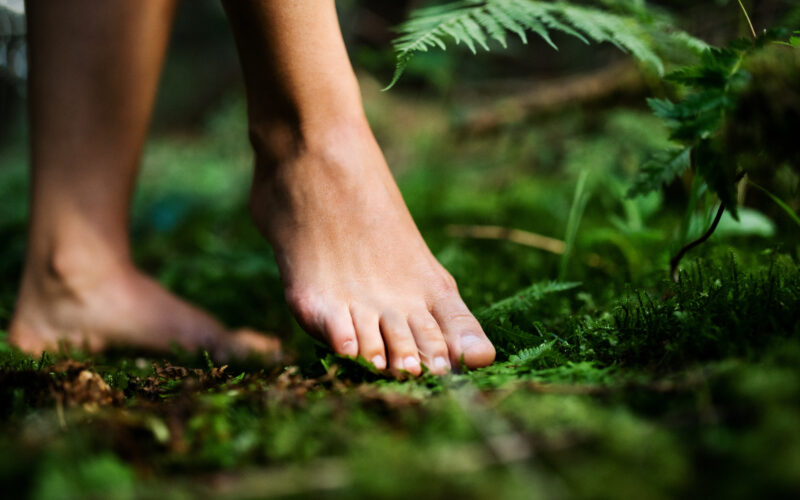Can walking barefoot on the earth really boost your health? Grounding, or earthing, is said to reduce stress, improve sleep, and ease inflammation by reconnecting the body with the earth’s natural energy. But is there real science behind it, or is it just another wellness trend? Let’s explore whether grounding lives up to the hype.
What is grounding?
Grounding, also called earthing, is the wellness practice of walking barefoot on the earth. It specifically involves making direct contact with the ground and using the earth’s electrical charge to stabilize the body, which purportedly has a positive impact on health. The key is to create a connection between your skin and the earth’s surface.
The earth has a slightly negative charge while the body has a slightly positive charge. The earth can thus absorb your body’s charge and may donate its own electrons to balance things out. Without contact with the ground, the body can build up a positive charge which contributes to free-radicals and oxidative stress. Grounding can reverse this. Or, at least that’s the theory. (More on that below.)
Roots in Chinese and Ayurvedic medicine
The concept of grounding has been promoted by certain cultures and practices of medicine for centuries, including traditional Chinese and ayurvedic medicine. Many ancient cultures believed living creatures were connected to the energies of the earth and the foundations of health included keeping these energies in balance. For example, Chinese medicine promotes the belief that grounding stimulates good energy–known as ‘qi’–through the body. Ayurvedic medicine teaches that grounding balances one of the humors (vata) that regulates a person’s emotional and mental health.
How to practice grounding
Certains different ways to practice grounding include walking barefoot in the grass, sitting or laying
on the ground, or getting in water. And if you can’t get outside or don’t have access to these spaces, grounding can also mean just having an electrode device connected to you and plugged into a grounded wall outlet. You can even buy grounding mats or sheets–made with conductive materials that connect to the Earth’s electrical charge via a grounded outlet plug–to sit, lay, or sleep on that run from a handful to hundreds of dollars.
Some of the theory behind grounding stems from the fact that our ancestors were much more in touch with the physical ground than we are. In modern societies, we no longer sleep on the ground, and many of us rarely walk barefoot outdoors. Consider also that when our forebears a fait wear shoes, they were historically made with traditional, conductive materials like leather–not the synthetic/man made soles worn today. Now, we live, work, and spend most of our time indoors, disconnected, far above the ground in multi-level buildings.
Does grounding have specific benefits?
The reported benefits of grounding are vast. Proponents claim grounding stabilizes the body’s physiology, reduces inflammation, pain, and stress, improves sleep, blood flow, and lymphatic/venous return to the heart, and produces greater well-being [1].
Many people on social media claim grounding techniques or products have been the ‘magic bullet’ for their health and well-being. There’s even an entire subReddit thread on Earthing with over 9,000 members. One user sleeps “on a grounding mat and the difference is very noticeable.” Another said “grounding didn’t magically cure me of any of it, but it certainly has helped my body recover and head in the right direction for long term health.”
Is there any actual science to back it up?
All of this sounds really great, but is there any evidence to back up these claims? Let’s take a look.
Un review article publié dans le Journal of Inflammation Research reported studies showing that grounding–including walking on the earth and sleeping on a grounding mat–can reduce signs of inflammation following injury— like redness, heat, swelling, and pain [2]. The researchers observed resolution of painful chronic inflammation, but only looked at a handful of case studies.
Autre étude dans le Journal international des sciences moléculaires found that grounding (defined as lying on a grounding mat) helped reduce symptoms of stress and anxiety in rats [3]. Researchers observed that the grounding mat led to lower levels of a stress-related brain chemical (corticotropin-releasing factor, or CRF). But, needless to say, rats aren’t people and it’s unclear whether this finding can be applied to grounding mat use by humans.
Additionally, other existing studies aren’t controlled for a specific grounding or earthing practice [4]. Some participants might walk barefoot, others might lay outside in the sun, while others might wade in the water. If some people felt better after grounding, it’s impossible to tell what exactly made them feel better–perhaps it was simply getting exercise, resting, or getting outside.
Grounding babies in the NICU
Perhaps one of the most compelling studies examining the concept of grounding comes from observing babies in a NICU. Remember how one method of grounding can simply involve having an electrode connected to you that’s plugged into a grounded wall outlet? A fascinating study from Pennsylvania State University observed whether they could reduce the electromagnetic charge of preterm babies in the NICU. Researchers electrically grounded 26 babies by connecting an electrode wire from the infants’ incubators or open cribs to the ground, and then measured the babies’ skin voltage and/or heart rate variability (an indicator of your autonomic nervous system, controlling involuntary functions). The researchers found that the babies were “more relaxed when grounded.” Again, however, more research is needed to generalize these observations.
The benefits of going outside
Despite scant and/pr low-quality evidence to support the practice of grounding, many individuals–particularly those in the holistic or naturopathic fields–réclamer grounding is an overlooked factor in health and wellness and should be recommended to everyone [1]. But, again, is it possible that the purported benefits of ‘grounding’ are actually just the benefits of going outside?
Spending time outdoors has many avantages pour la santé, both physically and mentally. Exposure to natural sunlight enables the body to produce vitamin D, which is essential for bone health, immune function, and reducing inflammation. Engaging in outdoor activities like walking, hiking, or playing sports promotes cardiovascular health, strengthens muscles, and enhances overall fitness. Being in nature has been lié to lower blood pressure and a reduced risk of chronic illnesses such as heart disease and diabetes.
In one étude, people who spent just two hours weekly in nature had more positive reports of health and well-being [5]. The researchers noted that these data should encourage additional research into what specifically about being outdoors leads to positive effects.
Time outside also significantly benefits mental wellbeing. You can lower stress, anxiety, and depression while improving mood and cognitive function by simply being outdoors. Time spent in green spaces has been associated with increased focus, creativity, and improved memory. Nature exposure also helps regulate sleep patterns by reinforcing the body’s natural circadian rhythms, leading to better sleep quality. Whether it’s a short walk in the park or a weekend hiking trip, regular outdoor activities can have profound benefits for both body and mind.
The benefits of bare feet
There are also benefits to walking barefoot, whether in contact with the earth or on any surface. Walking barefoot can strengthen the feet and improve balance. One small étude found that adolescents who walked barefoot for 30 minutes for twelve weeks had improved cognitive function (including concentration and reduced brain stress) compared to those wearing sneakers during the exercise [6].
The bottom line on grounding
While there is certainly a lot of buzz around grounding, there are few quality studies investigating its benefits. The studies that do exist lack scientific rigor, either because of very small sample size, lack of a control group, or poor overall design (such as not distinguishing what type of grounding or earthing practices participants engaged in).
While there is certainly a lot of buzz around grounding, there are few quality studies investigating its benefits. The studies that do exist lack scientific rigor, either because of very small sample size, lack of a control group, or poor overall design.
Furthermore, the fact there are proven benefits to spending time outside begs the question: is it grounding or earthing that makes a difference, or is it just fresh air and sunshine that pack the biggest punch? Alternatively, could walking barefoot itself be beneficial, and it really doesn’t matter if it’s barefoot on the earth or in your house? As with many popular wellness claims, there seems to be more hype to grounding than actual evidence-based benefit.
Still, while there’s limited evidence behind the theory of electrical energy balancing from grounding or earthing, getting outside is definitely a good idea! Stepping outside into the sunshine is free and requires little effort, there are numerous mental and physical health benefits to it. And, if you want to do so barefoot, perhaps it’s all the better.







